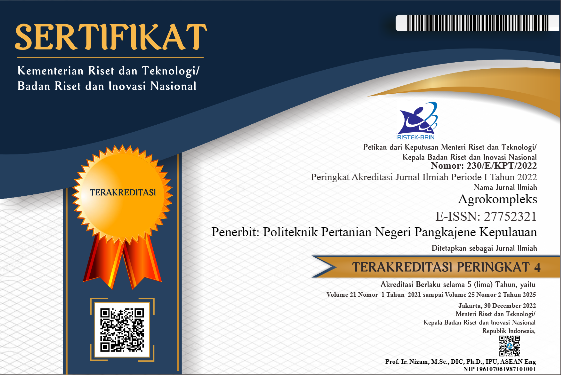Aktivitas Antioxidant, Polifenol Dan Evaluasi Sensori Cokelat Oles Fortifikasi Red Palm Olein Dari Biji Kakao Pilihan Klon Sulawesi Barat
Abstract
Sulawesi Barat merupakan salah satu penghasil kakao utama dengan kontribusi sekitar 22 % terhadap produksi kakao di wilayah Sulawesi. Pengembangan kakao fermentasi dan tanpa fermentasi dalam pembuatan produk cokelat oles memberikan alternatif baru sebagai pangan fungsional. Penelitian ini bertujuan untuk karakterisasi aktivitas antioksidan, polifenol, karotenoid dan sensori pada produk cokelat oles menggunakan biji kakao pilihan melalui variasi cocoa liquor, gula aren dan red palm olein sehingga diperoleh produk cokelat oles fungsional. Parameter analisis karakteristik cokelat oles menggunakan Uji kuantitatif kadar polifenol total dengan metode Folin Ciocalteau, kadar total flavanoid, asam lemak bebas dan aktivitas antioksidan menggunakan metode DPPH IC50, serta analisis organoleptik menggunakan metode hedonik tingkat kesukaan. Fortifikasi cokelat oles menghasilkan kadar asam lemak bebas 0.88%, polifenol 2,6%, karotenoid 122.12 mg/g dan aktivitas antioksidan terkuat kisaran 24.1-26.4%. Cokelat oles variasi cocoa liquor, gula aren dan subtitusi lemak kakao dengan red palm olein, secara umum disukai oleh panelis dari segi rasa dan aroma. pemanfaatan gula aren dan red palm olein memberikan efek fungsional yang baik untuk produk cokelat oles sehingga sangat baik dikonsumsi untuk kesehatan karena bersifat pangan fungsional.
References
Al-Saqer, J. M., Sidhu, J. S., Al-Hooti, S. N., Al-Amiri, H. A., Al-Othman, A., Al-Haji, L., Ahmed, N., Mansour, I. B., & Minal, J. (2004). Developing functional foods using red palm olein. IV. Tocopherols and tocotrienols. Food Chemistry, 85(4), 579–583. https://doi.org/10.1016/j.foodchem.2003.08.003
Amevor, P. M., Laryea, D., & Barimah, J. (2018). Sensory evaluation, nutrient composition and microbial load of cashew nut–chocolate spread. Cogent Food & Agriculture, 4(1), 1–10. https://doi.org/10.1080/23311932.2018.1480180
Beckett, S. T. (2009). Traditional Chocolate Making. In Industrial Chocolate Manufacture and Use: Fourth Edition. https://doi.org/10.1002/9781444301588.ch1
Carnésecchi, S., Schneider, Y., Lazarus, S. A., Coehlo, D., Gossé, F., & Raul, F. (2002). Flavanols and procyanidins of cocoa and chocolate inhibit growth and polyamine biosynthesis of human colonic cancer cells. Cancer Letters, 175(2), 147–155. https://doi.org/10.1016/S0304-3835(01)00731-5
Do, Q. D., Angkawijaya, A. E., Tran-Nguyen, P. L., Huynh, L. H., Soetaredjo, F. E., Ismadji, S., & Ju, Y. H. (2014). Effect of extraction solvent on total phenol content, total flavonoid content, and antioxidant activity of Limnophila aromatica. Journal of Food and Drug Analysis, 22, 296–302. https://doi.org/10.1016/j.jfda.2013.11.001
El-Hadad, N. N. M., Youssef, M. M., Abd El-Aal, M. H., & Abou-Gharbia, H. H. (2011). Utilisation of red palm olein in formulating functional chocolate spread. Food Chemistry, 124(1), 285–290. https://doi.org/10.1016/j.foodchem.2010.06.034
El-kalyoubi, M., Khallaf, M. F., Abdelrashid, A., & Mostafa, E. M. (2011). Quality characteristics of chocolate – Containing some fat replacer. Annals of Agricultural Sciences, 56(2), 89–96. https://doi.org/10.1016/j.aoas.2011.05.009
Galvan D’Alessandro, L., Kriaa, K., Nikov, I., & Dimitrov, K. (2012). Ultrasound assisted extraction of polyphenols from black chokeberry. Separation and Purification Technology. https://doi.org/10.1016/j.seppur.2012.03.024
Godočiková, L., Ivanišová, E., & Kačániová, M. (2017). The Influence of Fortification of Dark Chocolate with Sea Buckthorn and Mulberry on the Content of Biologically Active Substances. Advanced Research in Life Sciences, 1(1), 26–31. https://doi.org/10.1515/arls-2017-0004
Grassi, D., Lippi, C., Necozione, S., Desideri, G., & Ferri, C. (2005). Short-term administration of dark chocolate is followed by a significant increase in insulin sensitivity and a decrease in blood pressure in healthy persons. American Journal of Clinical Nutrition, 81(3), 611–614. https://doi.org/10.1093/ajcn/81.3.611
Jeyarani, T., Banerjee, T., Ravi, R., & Krishna, A. G. G. (2013). Omega-3 fatty acids enriched chocolate spreads using soybean and coconut oils. Journal of Food Science and Technology, 52, 1082–1088. https://doi.org/10.1007/s13197-013-1053-4
Liu, S. C., Lin, J. T., Wang, C. K., Chen, H. Y., & Yang, D. J. (2009). Antioxidant properties of various solvent extracts from lychee (Litchi chinenesis Sonn.) flowers. Food Chemistry, 114(2), 577–581. https://doi.org/10.1016/j.foodchem.2008.09.088
Manzocco, L., Calligaris, S., Camerin, M., Pizzale, L., & Nicoli, M. C. (2014). Prediction of firmness and physical stability of low-fat chocolate spreads. Journal of Food Engineering, 126, 120–125. https://doi.org/10.1016/j.jfoodeng.2013.10.042
Mayamol, P. N., Balachandran, C., Samuel, T., Sundaresan, A., & Arumughan, C. (2007). Process technology for the production of micronutrient rich red palm olein. JAOCS, Journal of the American Oil Chemists’ Society, 84, 587–596. https://doi.org/10.1007/s11746-007-1078-9
Misnawi, Jinap, S., Jamilah, B., & Nazamid, S. (2003). Effects of incubation and polyphenol oxidase enrichment on colour, fermentation index, procyanidins and astringency of unfermented and partly fermented cocoa beans. International Journal of Food Science and Technology, 38(3), 285–295. https://doi.org/10.1046/j.1365-2621.2003.00674.x
Serafini, M., Bugianesi, R., Maiani, G., Valtuena, S., De Santis, S., & Crozier, A. (2003). Plasma antioxidants from chocolate. Nature, 424, 1013–1018. https://doi.org/10.1038/4241013a
Shanmugapriya, K., Saravana, P. S., Payal, H., Peer Mohammed, S., & Binnie, W. (2011). Antioxidant activity, total phenolic and flavonoid contents of Artocarpus heterophyllus and Manilkara zapota seeds and its reduction potential. International Journal of Pharmacy and Pharmaceutical Sciences, 3(5), 256–260.
Stokes, C. N., O’Sullivan, M. G., & Kerry, J. P. (2017). Hedonic and descriptive sensory evaluation of instant and fresh coffee products. European Food Research and Technology, 243(2), 331–340. https://doi.org/10.1007/s00217-016-2747-4
Sundram, K. (2005). Meeting the Rising Health Awareness : The Palm Oil and Consumer Perception. Palm Oil Developments, 43, 20–28.






